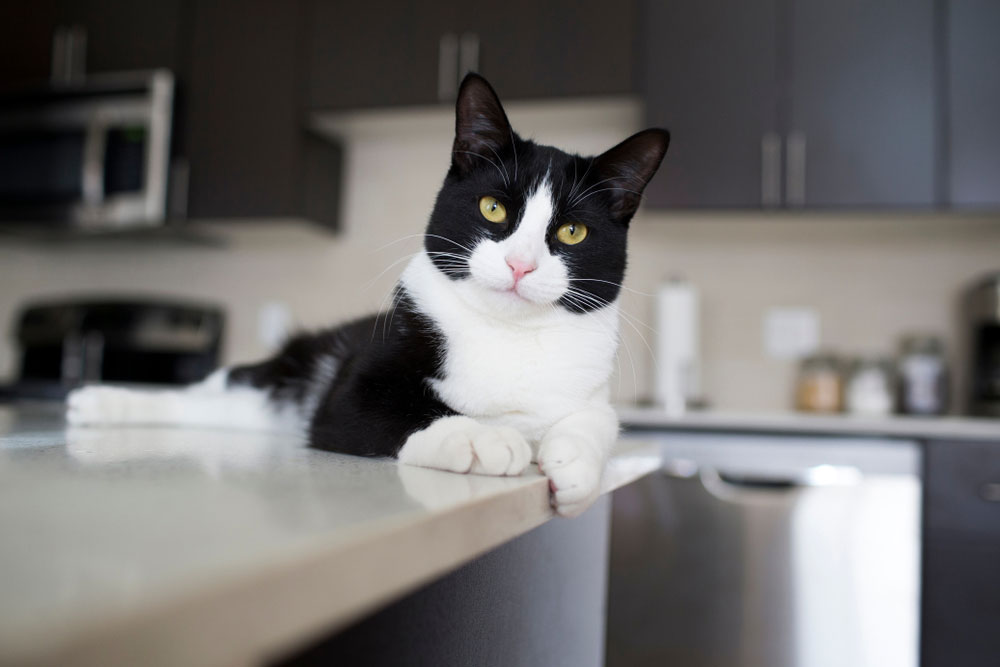Cats love to hang out on kitchen counters, tables, dressers, and any other high spots. The kitchen counter is where we prepare our food, so it is no surprise that we want to keep cats off counters. They walk around in their litter boxes, after all. Ew!
Wiping down counters after each meal with an antibacterial soap helps keep us safe from E. coli and Salmonella, among other harmful organisms. But it would be better to keep our kitties off the counters to start with. Your friends at Union Lake Pet Services are here with suggestions on how to keep cats off counters. Let’s begin!
What’s the Deal with Cats and Counters?
In order to change any behavior in a pet you must understand their motives and what they get out of doing it. No, your well-behaved kitty isn’t being ornery (or, maybe they are!). In most cases, being on counters is just a part of their instinct and drive.
- Cats naturally want to climb high – In the wild, this gives them greater views over possible prey or potential predators, since they have a visual advantage.
- Cats need to know their territory – No stone will be left unturned when it comes to your cat because they like to be familiar with their surroundings. For them, it is safe to understand where everything is and how best to navigate it, if they suddenly have to pounce or run.
- Does the counter have a window view – Cats love to look outside at all the (tasty) birds and other wildlife in the yard. Can you imagine being indoors all the time? Looking at the world is a good form of mental enrichment for cats so counters are appealing if they provide a view.
- Counters have all the smells – No matter how much you clean the counter, there is still the lingering scent of food to your cat’s discerning sense of smell. From food prep to food storage, the counter is a smorgasbord of good odors for your feline.
Now that you know a few of the reasons why cats like counters, let’s explore how to discourage them with some positive solutions and training.
Training to Keep Cats Off Counters
Like dogs, training a cat means giving them reasons to NOT be on counters by some simple redirection. Redirecting your cat to do what you want is much more than saying “no” or scolding them. They learn through positive reinforcement.
Here are a few effective ways to encourage better behavior.
- Invest in cat trees – If your cat likes to climb, find some things that are cat friendly, like cat trees that have varied heights. Put these in places around the home, especially in areas where you spend a lot of time, like the kitchen. Add toys on the cat tree to reward your kitty for using it.
- Create outdoor views – Open curtains to patio doors and windows, so your cat can get a clear view. Consider adding bird feeders, as well as planting a garden that attracts butterflies, bees, and other insects. Good for the earth and your cat!
- Clear off bookshelves, windowsills, and the backs of couches – These open and high areas will give your cat new places to explore that don’t include the kitchen counter.
- Give your cat more exercise – Your cat may be bored and want to interact more with you. Try new games, such as a feather wand or laser pointer.
- Distract or confine your cat during meal prep – give your cat a food toy to distract them if your cat is jumping on counters or the table during meals or meal prep. Alternative, confine them in another room during the meal.
- Don’t punish – punishments like spray bottles or yelling creates anxiety in cats which can trigger other problems. Also, cats aren’t good about connecting their actions with the consequences.
Make the Counter an Uninviting Place
Once you give your cat reasons to be elsewhere, and more engaged and active through exercise, turn your attention to the counter.
- Make counters less appealing by putting away food items that are normally stored on the counter.
- Keep the counters clean by wiping them down often. Consider using citrus, like lemon juice, and vinegar to clean cabinets, as cats dislike the smell.
- Add double-sided tape to one side of cheap plastic placemats. Place on the counters when not in use. Cats hate sticky surfaces. Once your cat stops jumping on the counter, gradually remove the placemats.
It’s not an impossible feat to keep cats off counters but you may never fully win the battle. Some cats will do it less but may never stop completely. With our tricks and tips, though, you can train your cat to use other parts of the home for their naps and lounge-time.
For more information on cat training, please phone us!

